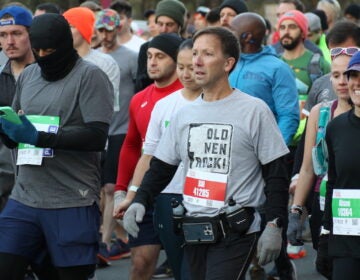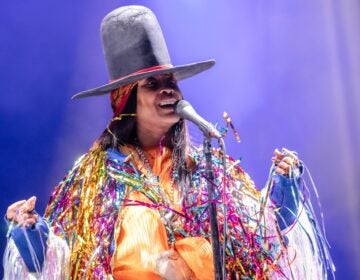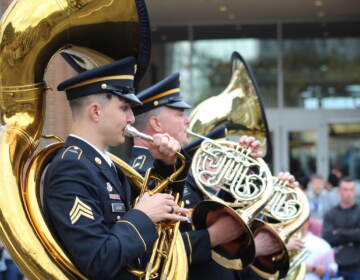Documentary ‘Albatross’ shows how our obsession with plastic is killing this bird
The film, screening April 14, will be a featured selection of this year’s Princeton Environmental Film Festival.
-

Albatross birds are among the largest sea birds. (Image from Albatross documentary)
-

The Albatross eats squid but often consumes plastic debris that can kill them. (Image from Albatross documentary)
-

Albatross birds are masters at soaring through the wind without flapping their wings. They can spend years over the ocean without touching land. (Image from Albatross documentary)
If ever there was a single thing that says “enough,” it’s the sight of a bird’s intestines filled with bottle caps and other debris it has mistaken for nourishment.
“Abatross,” a film by Chris Jordan, simultaneously enchants the viewer with scenes of the white sea bird living on the Hawaiian island of Midway, and tells the sickening story of baby birds who die when their bellies fill with plastic — everything from cigarette lighters and syringes to credit cards.
The film (screening April 14 at 7 p.m.) will be a featured selection of this year’s Princeton Environmental Film Festival (April 8 through 15), and Jordan, the Seattle-based artist who wrote, directed, edited and narrated the film, will be present for a post-screening conversation.
“Albatross” opens with still shots of birds who have died and begun to decompose, but not the plastic contents of their bellies because, as we know, plastic lives forever (that’s even the title of another film in the festival). As horrifying as it may sound, Jordan has composed his images with beauty. He first came to Midway Island as a still photographer documenting the impact on these birds. As his stills turn to video, we see the viridian water lapping at the beach amid the devastation. “This is our culture turned inside out,” says the narrator.
We are brought into intimate contact with the bird, within touching distance of its webbed feet, its hooked bill and dark eyes. So close are we, it almost looks as if the albatross is gesturing to say, “Come in and stay a while.” The albatross, we are told, has no natural predator and therefore has no fear of humans. As such, Jordan can bring us so close that it’s as if we’re seeing through their eyes, getting inside their minds.
During his initial visit to document the cut-open belly contents, Jordan was struck by seeing tens of thousands of dead birds, but none alive. When he returned to the island he met the living birds “and fell crazy in love.”
“I am appalled by these scenes, and yet also drawn to them with awe and fascination,” he said. “The pervasiveness of our consumerism holds a seductive kind of mob mentality. Collectively we are committing a vast and unsustainable act of taking, but we each are anonymous and no one is in charge or accountable for the consequences… Being with these graceful and elegant beings who have no fear of us was profoundly disturbing and incredibly sad, seeing them come up to us, their bodies filled with plastic. It is our fault and they didn’t know that.”
The voice Jordan narrates the film with conveys his personal sense of loss. Indeed in one touching scene we watch him mourning a bird.
Jordan, a former lawyer who changed career in midlife, said “Albatross” is his “gift to world — I’m close to having to declare bankruptcy, but it feels like giving the film as a gift is part of the art. I can’t treat it like a commercial project, there’s nothing commercial about it. It came to me and changed my life, it’s been a spiritual experience to be with the birds and I want to transfer that experience to the viewer — it was an easy choice to have given up money.”
Jordan even served as the film’s sound designer. A musician as well as an artist, he composed and performed some of the music. In an unconventional way, he created the soundtrack first and then cut the film to the sound. “Real music is its own deep poetic art form with a story arc and I wanted to use pre-existing music that had those elements.”
So just why, then, does the albatross eat plastic? “That’s the heart of the matter — they can’t know what plastic is,” said Jordan. “It’s what they do, fly out over the sea and scavenge bite-size pieces of anything that floats on the surface of water, from dead squid to tropical nuts from Madagascar covered with seaweed. They digest and cough out the rest, like an owl who will swallow a whole mouse, then cough out the bones and fur they cannot digest. Albatrosses don’t have the ability to distinguish what they should and shouldn’t eat. After a week foraging over the Pacific, when their belly is full, they return to the nest to feed their baby. The babies digest what they can but can’t digest plastic so it stays in their stomach until the belly is distended. When the entire cavity is filled and they can’t fit any more in, they starve to death.
“The way I look at it, there isn’t anything any individual can do,” he continues. “We think of the ocean plastic as an isolated problem, but just like climate change and the destruction of forests all these problems all related. This is my call to action.”
The Princeton Environmental Film Festival opens Sunday, April 8, 7 p.m. with “Where the Wind Blew,” closes April 15 with “Delores,” a profile of 87-year-old Dolores Huerta, an equal partner in co-founding the first farm workers unions with Cesar Chavez. Some of the highlights are “Jane” on April 9, about Jane Goodall; “Five Seasons: The Gardens of Piet Oudolf” (landscape designer of New York City’s Highline); and, as part of the Princeton Migrations Project, “The Iron Triangle,” about immigrants who work in the interconnected network of hundreds of small auto repair shops in Willets Point, Queens, N.Y. For the full schedule of films and events, visit the festival website.
WHYY is your source for fact-based, in-depth journalism and information. As a nonprofit organization, we rely on financial support from readers like you. Please give today.





